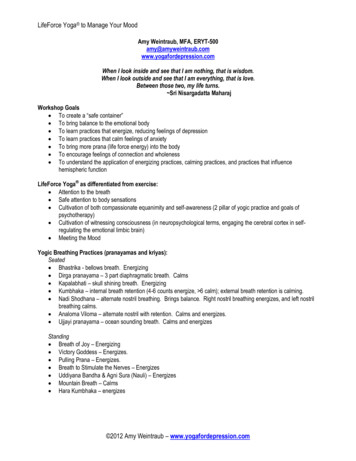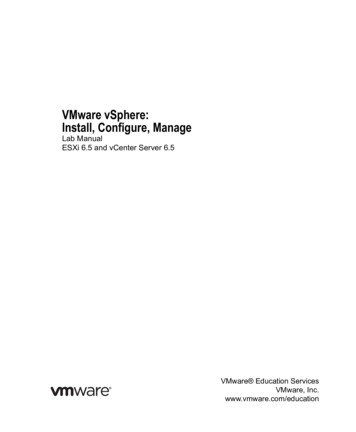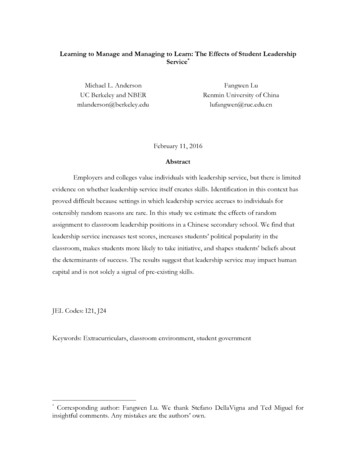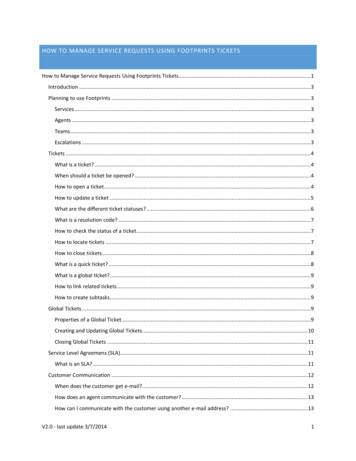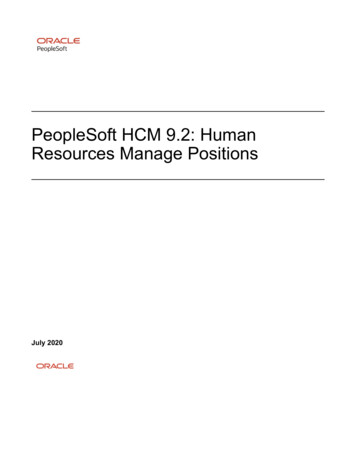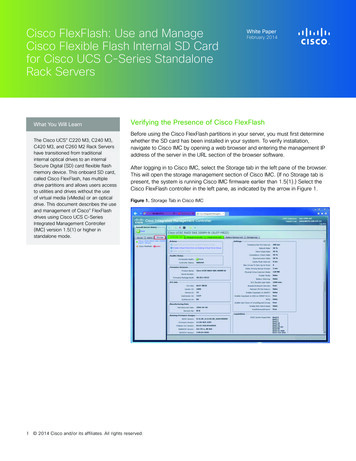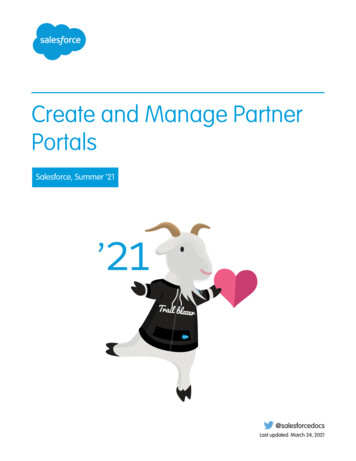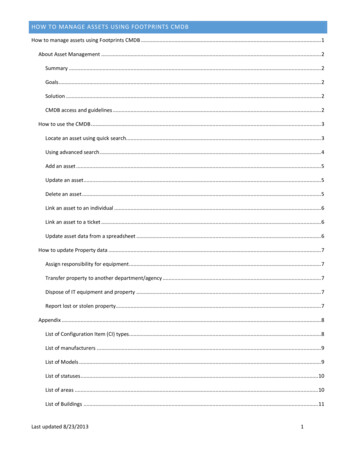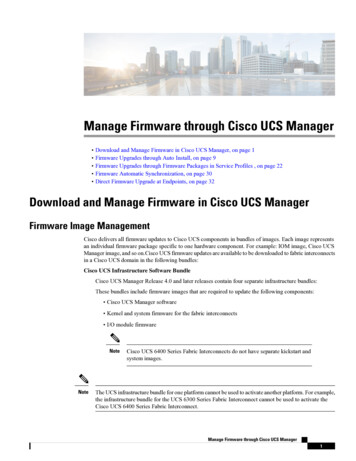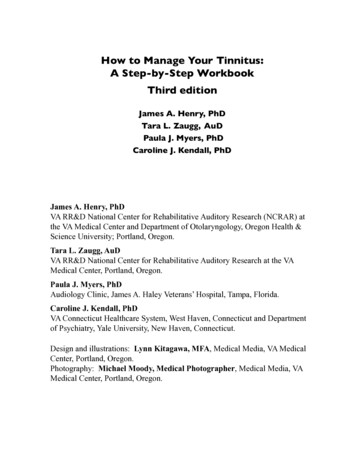
Transcription
How to Manage Your Tinnitus:A Step-by-Step WorkbookThird editionJames A. Henry, PhDTara L. Zaugg, AuDPaula J. Myers, PhDCaroline J. Kendall, PhDJames A. Henry, PhDVA RR&D National Center for Rehabilitative Auditory Research (NCRAR) atthe VA Medical Center and Department of Otolaryngology, Oregon Health &Science University; Portland, Oregon.Tara L. Zaugg, AuDVA RR&D National Center for Rehabilitative Auditory Research at the VAMedical Center, Portland, Oregon.Paula J. Myers, PhDAudiology Clinic, James A. Haley Veterans’ Hospital, Tampa, Florida.Caroline J. Kendall, PhDVA Connecticut Healthcare System, West Haven, Connecticut and Departmentof Psychiatry, Yale University, New Haven, Connecticut.Design and illustrations: Lynn Kitagawa, MFA, Medical Media, VA MedicalCenter, Portland, Oregon.Photography: Michael Moody, Medical Photographer, Medical Media, VAMedical Center, Portland, Oregon.
DedicationThis book is dedicated to our nation’s military Veterans. We thank you forserving our country. You are the reason we enjoy freedom.AcknowledgmentsDevelopment and publication of this book was supported by VA RehabilitationResearch and Development (RR&D) Service, the NCRAR, and VA EmployeeEducation System. Numerous individuals have contributed in various andsignificant ways toward this effort, including: Russell L. Bennett (Computer Specialist, Long Beach EmployeeEducation Resource Center, Long Beach, California) Daniel C. Garcia (Graphic Designer, Long Beach Employee EducationResource Center, Long Beach, California) Katie J. Fick, MS (Research Assistant, James A. Haley Veterans’ Hospital,Tampa, Florida) Jeff Hall (Production Sound Mixer, Salt Lake City Employee EducationResource Center, Salt Lake City, Utah) Christine Kaelin, MBA (Clinical Research Coordinator, NCRAR,Portland, Oregon) David Lehman (Executive Producer, Salt Lake City Employee EducationResource Center, Salt Lake City, Utah) Marcia Legro, PhD (Research Psychologist, Seattle, Washington) Will Murphy (Audiovisual Production Specialist, Portland VA MedicalCenter) Kimberly Owens, MPH (Clinical Research Coordinator, Saint ThomasResearch Institute, Nashville, Tennessee) Emily Thielman, MS (Research Assistant, NCRAR, Portland, Oregon) Dwayne Washington (Audiovisual Production Specialist, Portland VAMedical Center) John C. Whatley, PhD (Project Manager, Birmingham EmployeeEducation Resource Center, Birmingham, Alabama)Also, thanks to Stephen Fausti, PhD and Sara Ruth Oliver, AuD for theircontinued support of tinnitus research and clinical activities at the PVAMC.
My Contact Information
Table of ContentsPart 1. IntroductionWhat is Tinnitus?Should I See a Physician?Tinnitus at a GlanceHow Can This Workbook Help Me?Goals of Tinnitus Management (All Methods)112467Part 2. Step-by-Step Guide: Using Sound toManage Tinnitus9Tinnitus and Hearing Survey9Using Sound to Manage Reactions to TinnitusEnvironmental Sound, Music, and SpeechSound GridSoothing SoundBackground SoundInteresting SoundTest Your Understanding12131314172225Develop a Personal “Sound Plan”Key Points for Your First Sound Plan WorksheetOngoing Use of the Sound Plan WorksheetHow to Fill Out the Sound Plan WorksheetTinnitus Problem ChecklistExample of Completed Sound Plan Worksheet272727272930Part 3. Step-by-Step Guide: Changing Thoughtsand Feelings to Manage Reactions to Tinnitus37Relaxation ExercisesDeep BreathingImagery3840
Pleasant Activity Scheduling44Changing Thoughts48Changing Thoughts and Feelings Worksheet57Part 4. Protect Your Ears!61Standard Earplugs63Custom Earplugs63Hi-fi Earplugs64Electronic Earplugs64Earmuffs64Appendix A: Description of Tinnitus65Appendix B: What Causes Tinnitus?67Appendix C: Methods of Tinnitus Management72Appendix D: What To Do When Everyday Sounds Are Too Loud81Appendix E: Effects of Tinnitus84Appendix F: Effects of Hearing Loss87Appendix G: Examples of How People Use Sound to ManageReactions to Tinnitus88Appendix H: How to Choose Devices93Appendix I: Tips for Getting Better Sleep99Appendix J: Resources102References104Copies of Sound Plan WorksheetCopies of Changing Thoughts WorksheetManaging Your Tinnitus DVDManaging Your Tinnitus, Sound Demonstration CD
Read Me First This workbook does not, and cannot, provide individual medical advice. It isfor general information purposes only. The information is not intended to bea substitute for individual medical advice, diagnosis, or treatment by aphysician who is aware of your medical history and has examined you. Donot rely on this workbook in place of seeking professional medical advice. If you notice any significant change in hearing, tinnitus, or ear-relatedmedical problems, you should contact your primary care provider for referralto an audiologist or ENT (Ear, Nose, Throat) physician, as appropriate.Audiologists do not prescribe medication (drugs). Any medication concernsshould be directed to your primary care provider or other physician. Please contact an audiologist if you have any questions regarding theinformation contained in this workbook, or if you have questions abouttinnitus, hearing loss, or hearing aids. If you are a Veteran seeking a claim for service connected hearing loss ortinnitus, you should contact your VA Regional Office or Veteran ServiceRepresentative for information as to how to proceed. This workbook presents many different possible ways to manage reactions totinnitus. In general, VA endorses the method of Progressive TinnitusManagement (PTM). PTM provides a hierarchical structure for providingclinical services for tinnitus. That is, patients should receive services that“progress” to higher levels as needed. Proper evaluation and provision ofappropriate education are essential with PTM. Also, PTM is patientcentered and interdisciplinary, consistent with VA’s model of health care.However, VA does not endorse any specific device for tinnitus management.Any reference in this workbook (including photographs) to a device does notconstitute an endorsement. All of these references are for informationpurposes only. Also, the methods and devices for managing reactions totinnitus that are described in this workbook may or may not be available atyour regional VA medical center. It is intended that PTM will be available atall VA medical centers in the near future.
Part 1. IntroductionWhat is Tinnitus?Tinnitus is a ringing, humming, buzzing, or other sound in your head or ears thatdoes not have an outside source. The sound comes from within your head. Formost people, tinnitus is a constant sound. Tinnitus is not a disease - it is asymptom. (See Appendix A for a more complete description of tinnitus.)It's Sound!(no sound)1
Should I See a Physician?In most cases, having tinnitus does not mean that you need to see a physician.However, in some cases it is very important to see a physician. If youhave tinnitus, you can use the guide below. It will help you decide if you needto see a physician or other health professional.1 If you experience any of the following: Injury to your body Weakness or paralysis of any muscles in your face Sudden unexplained hearing loss in one or both earsGo to Emergency Care or to an ENT (Ear, Nose,Throat) clinic immediately.2 If you experience any of the following: Extreme anxiety or depression A current plan to end your life and a way to do itGo to Emergency Care or to a Mental Health clinicimmediately.3 If you experience any of the following: The tinnitus pulses with your heartbeat You have ear pain, drainage from your ear, or if there is a foul odor comingfrom your ear You have vertigo (the feeling that you are moving or the room is movingwhen neither is moving)Go to an ENT (Ear, Nose, Throat) clinic or to a physician as soon aspossible.2
4 If you have tinnitus, and all of the following are true: The tinnitus is a constant sound that does NOT pulse with your heartbeat You do NOT have ear pain, drainage from your ear, or foul odor coming fromyour ear You do NOT have vertigo You do NOT have weakness or paralysis of any muscles in your face You do NOT have sudden unexplained hearing lossSee an audiologist sometime in the near future. (An audiologist is anon-physician hearing healthcare provider.)3
Tinnitus at a GlanceWhat Causes Tinnitus?Anything that causes hearing loss also can cause tinnitus. The most commoncause of tinnitus is loud noise. Other causes include: Injury to the head or neck Various diseases Too much ear wax Stress Prescription drugsIn many cases, there is no known cause. To learn more about causes of tinnitus,see Appendix B.Can Tinnitus be Cured?A cure for tinnitus would mean that some treatment could silence it. Althoughresearch is being done to find a cure, there is no cure yet. There also is no safeand consistent way to reduce the loudness of tinnitus. We cannot change thetinnitus, but we can change our reactions to it. Changing reactions to tinnituscan make it less of a problem. The key is to learn how to manage our reactionsto tinnitus. The goal is to feel better even though the tinnitus does not change.Note: In this book we refer to “managing tinnitus.” We also refer to “tinnitusmanagement.” Both of these terms refer to managing reactions to tinnitus.Again, we can’t change the loudness of tinnitus, but we can change how wereact to it.How are Reactions to Tinnitus Managed?Methods that are used in clinics include: Sound-based methods (Tinnitus Masking1, Tinnitus Retraining Therapy2,Neuromonics Tinnitus Treatment3) Education4 Counseling/Psychotherapy (example: Cognitive-Behavioral Therapy)5, 6Each of these methods has been shown by research to help some people withtinnitus. To learn more about these and other methods, see Appendix C.4
Progressive Tinnitus ManagementThe suggestions in this book are based on the method of Progressive TinnitusManagement (PTM).7-9 PTM was developed at the National Center forRehabilitative Auditory Research. The method is “progressive” because noteveryone needs the same amount of help. Some people with tinnitus only needbasic questions answered. Other people need more than that. Still others needa great deal of help. With PTM, sound is used to manage reactions to tinnitus.However, PTM differs from the sound-based methods listed above. PTMteaches many different ways to use sound to manage tinnitus. Also, PTMteaches ways to change your thoughts and feelings to cope with tinnitus.What About “Alternative” Methods?There are many “alternative” methods, including: Acupuncture Hypnosis Vitamins and herbs HomeopathyNone of these methods has been shown by research to help people with tinnitusmore than placebo.10 (A placebo is like a “sugar pill.”) To learn more aboutalternative methods, see Appendix C.Isn’t There a Drug for Tinnitus?All drugs used for tinnitus are meant for other problems - like depression,anxiety, and trouble sleeping.10 Some of these drugs can improve mood. Abetter mood can help to make tinnitus less of a problem. In some cases, a drugcan reduce the loudness of tinnitus. However, drugs also can make tinnituslouder. Any use of drugs for tinnitus involves trial-and-error. Because ofpossible side effects, the use of drugs should be approached with caution. Tolearn more about drugs and tinnitus, see Appendix C.5
How Can This Workbook Help Me?There are three basic ways to manage reactions to tinnitus: (1) education andcounseling; (2) using sound; and (3) changing thoughts and feelings. These arethings that you can do on your own if you know what to do. You can learn whatto do by reading this workbook.1. EducationYou may have been told in the past to “learn to live with it” and “nothing can bedone.” This is not true. Doing the activities in this workbook can help you learnto manage your reactions to tinnitus and make it less of a problem.2. Use of SoundMost methods of tinnitus management involve using sound in some way. Part 2of this workbook shows you how to use sound to manage reactions to tinnitus.3. Changing Thoughts and FeelingsIn Part 3 of this workbook you will learn: Two different ways to relax About planning pleasant activities How to change your thoughts about tinnitusAll of these are different ways for you to change your thoughts and feelings.Changing your thoughts and feelings can help you manage your reactions totinnitus.6
Goals of Tinnitus Management(All Methods)There are many methods for managing reactions to tinnitus. These methods arenot intended to make your tinnitus quieter. They are intended to help you feelbetter - even if it’s just for a short time - without changing your tinnitus. Themore you practice feeling better, the easier it will become to feel OK with yourtinnitus just as it is. All of these methods have basically the same goals. Theyare to:Feel less stressed about tinnitusHave fewer emotional reactions to tinnitusAlmost never think about tinnitusFeel like tinnitus has little effect on daily activities (concentration, work,sleep, etc.)Feel like tinnitus is not much of a problemFeel like there is no need for further help learning to manage tinnitusAll of these goals can be accomplished without changing your tinnitus. Goahead and check the boxes above for the goals that apply to you. Use the spacebelow to write down any other goals you have. Keep in mind that this workbookcan help you with tinnitus problems, but not with trouble hearing. For help withtrouble hearing, please talk to an audiologist.7
What is your number one goal for managing your reactions to tinnitus?8
Part 2. Step-by-Step Guide:Using Sound to ManageReactions to TinnitusTinnitus & Hearing SurveyLater on in this workbook, we will be discussing “Bob’s” problems with tinnitusand how he learned how to manage them. Bob first filled out the Tinnitus andHearing Survey. His completed Survey is shown below. Please take a look athow Bob filled out the Survey. Then, answer these questions for yourself on thenext page.Over the last week, tinnitus kept me fromsleeping.01234Over the last week, tinnitus kept me fromconcentrating on reading.01234Over the last week, tinnitus kept me fromrelaxing.01234Over the last week, I couldn’t get my mindoff of my tinnitus.01234Grand TotalA. TinnitusNo,pro not ablemYes,apro smalblem lYes,apro modblem erateYes,abpro igblemYes,apro veryblem bigTinnitus and Hearing SurveyB. HearingOver the last week, I couldn’t understand whatothers were saying in noisy or crowded places.01234Over the last week, I couldn’t understand whatpeople were saying on TV or in movies.01234Over the last week, I couldn’t understandpeople with soft voices.01234Over the last week, I couldn’t understand whatwas being said in group conversations.01234Grand TotalTotal of each columnTotal of each columnC. Sound ToleranceOver the last week, everyday sounds were tooloud for me.*If you responded 1, 2, 3 or 4 to the statementabove:Being in a meeting with 5 to 10 peoplewould be too loud for me.*0123401234*If sounds are too loud for you when wearing hearing aids, please tell your audiologist9
Over the last week, tinnitus kept me fromsleeping.01234Over the last week, tinnitus kept me fromconcentrating on reading.01234Over the last week, tinnitus kept me fromrelaxing.01234Over the last week, I couldn’t get my mindoff of my tinnitus.01234Grand TotalA. TinnitusNo,pro not ablemYes,apro smalblem lYes,apro modblem erateYes,apro bigblemYes,apro veryblem bigTinnitus and Hearing SurveyB. HearingOver the last week, I couldn’t understand whatothers were saying in noisy or crowded places.01234Over the last week, I couldn’t understand whatpeople were saying on TV or in movies.01234Over the last week, I couldn’t understandpeople with soft voices.01234Over the last week, I couldn’t understand whatwas being said in group conversations.01234Total of each columnC. Sound ToleranceOver the last week, everyday sounds were tooloud for me.*If you responded 1, 2, 3 or 4 to the statementabove:Being in a meeting with 5 to 10 peoplewould be too loud for me.*0123401234*If sounds are too loud for you when wearing hearing aids, please tell your audiologist10Grand TotalTotal of each column
I Completed the Tinnitus and Hearing Survey What Does it Tell Me?Sections A and B. Tinnitus problems are managed in a different way thanhearing problems. The problems in Section A of the Survey are tinnitusproblems. You can use this workbook to learn how to manage tinnitus problems.The problems in Section B are hearing problems. This workbook does notexplain how to handle hearing problems. Any hearing professional can help youlearn how to manage hearing problems.Section C. The two questions in section C are about trouble tolerating sound. Ifyou circled any number greater than “0,” then read Appendix D. If you circled“2” or greater on the second question, please talk to a hearing professional.Grand Totals for A and B If the Grand Total for A is greater than for B, then you probably have moretrouble with tinnitus than with hearing. If the Grand Total for B is greater than for A, then you probably have moretrouble with hearing than with tinnitus.Note: Hearing problems are often helped by hearing aids. Hearing aids can alsomake tinnitus less of a problem. To learn why hearing aids can be helpful fortinnitus, please see Appendix C.More Information. See Appendix E to learn more about the effects of tinnitusand why it can be a problem. See Appendix F to learn more about the effects ofhearing loss.11
Using Sound to Manage Reactionsto TinnitusIn general, there are three types of sound that can be used to manage reactions totinnitus:1 Soothing Sound - makes you feel better as soon as you hear it. It helpsreduce stress or tension caused by tinnitus.2 Background Sound - reduces contrast between tinnitus and a quietenvironment. It makes it easier to ignore tinnitus.3 Interesting Sound - keeps your attention. It helps shift attention away fromtinnitus.Some types of sound can be used in more than one way at the same time. Forexample, interesting sound can help to shift attention away from tinnitus. At thesame time it can help to reduce stress and tension from tinnitus. Some types ofsound can be used in all three ways at the same time. The circles in the figureoverlap as a reminder that the types of sound can overlap. Regardless of howyou use sound, the goal is to help you live with your tinnitus more comfortably.We will now explain each of these three types of sound for managing tinnitus.12
Environmental Sound, Music, and SpeechFor each type of sound (soothing, background, interesting) you can useenvironmental sound, music, or speech. Please see the Sound Grid below.Note: Environmental sound is any sound that is not music or speech.Environmental sounds can be nature sounds (like the sound of ocean waves orinsects), or manmade sounds (like fan noise and masking noise).Sound GridThe Sound Grid is shown below. It shows that each type of sound (soothing,background, interesting) can be environmental sound, music, or speech. Thisresults in nine possible combinations. There is one checkmark on the SoundGrid for each combination.Sound GridEnvironmentalMusicSpeechSoothing Background Interesting 13
Soothing SoundWhat is Soothing Sound? Any sound that makes you feel better as soon asyou hear it You can use environmental sound, music, orspeech as soothing soundHow can Soothing Sound Help? By giving you a sense of relief from tension andstress caused by tinnitusSoft breezesSoothing voiceBabbling brookTINNITUSRelaxing musicRunning waterOcean wavesSoothing soundWhen can I use Soothing Sound? Any time your tinnitus bothers youErnest uses nature sounds from histabletop sound generator to helphim get to sleep. The nature soundsgive him a sense of relief from stressand tension caused by tinnitus. Thesense of relief makes it easier forhim to get to sleep.Lee plays recordings of Hawaiian musicthrough his iPod while he is at work. Themusic gives him a sense of relief fromstress and tension caused by
This workbook presents many different possible ways to manage reactions to tinnitus. In general, VA endorses the method of Progressive Tinnitus Management (PTM). PTM provides a hierarchical structure for providing clinical services for tinnitus. That is, patients should rec
